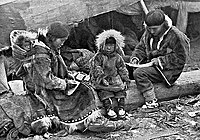
Photo from wikipedia
BackgroundCompare at-home and away-from-home snacking patterns of US infants and young children.MethodsA secondary analysis was conducted using nationwide, cross-sectional dietary survey data from the US Feeding Infants and Toddlers Study… Click to show full abstract
BackgroundCompare at-home and away-from-home snacking patterns of US infants and young children.MethodsA secondary analysis was conducted using nationwide, cross-sectional dietary survey data from the US Feeding Infants and Toddlers Study (FITS) 2008. The sample included infants (6–11.9 months, n = 505), toddlers (12–23.9 months, n = 925), preschool children (24–47.9 months, n = 1461). Weighted population descriptive statistics (means and standard errors) were calculated using SAS. Significance was determined at P ≤ 0.05. The main outcome measures of the analyses were the percent of children consuming snacks by location (at home, away from home) and snacking period (morning, afternoon and evening), energy and food groups consumed during snacks.ResultsSnacking at home was more prevalent than snacking away from home (toddlers, 73% vs 27%; preschoolers, 67% vs 33%). Away-from-home snacks provided about 50 additional calories per day for toddlers (346 vs 298 kcal/day, P ≤ 0.05) and preschoolers (371 vs 326 kcal/day, P ≤ 0.05) versus snacks consumed at home. Caregivers made similar snack choices for toddlers and preschoolers (milk/milk products, fruit/juice, grains and sweets) but differed in frequency of consumption by location. Among toddlers, milk/milk products were the most frequently consumed snacks at home (66%), while sweets were the top snacks consumed away from home (69%). Among preschoolers, sweets were the top snacks both at home (60%) and away (83%).ConclusionsLocation is an important factor influencing snacking patterns of young children and should be considered when developing feeding guidelines. This data may be of use in the upcoming development of dietary guidelines in the U.S. for the population aged 0–2 years.
Journal Title: BMC Public Health
Year Published: 2018
Link to full text (if available)
Share on Social Media: Sign Up to like & get
recommendations!